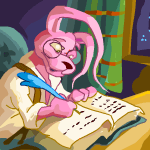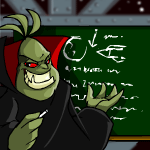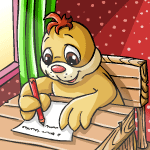 You've Mastered the Basics--Now What? Part 1
by cosmicfire918
--------
If you want to start writing stories for the Neopian Times, there are a ton of great guides for beginning writers in the many past issues of Neopia’s spectacular user-content newspaper. Fiction writing is not an endeavor to be taken lightly, and many NT writers have graciously passed on their knowledge and their experience on the subject to those who have never written a story before, or perhaps keep getting their stories rejected and want to figure out why.But let’s say you’ve got all of that down. You have multiple golden quills to your username. You know that plots need to have a beginning, middle, and end. You understand why stereotyping Neopet species is problematic. You’ve memorised what is and isn’t allowed in the Times. And you’re ready to take your writing to the next level. Then this series of articles is for you. I make no claim to being a spectacular writer—but I have been writing fiction for a fairly long time, have accumulated a lot of know-how from various sources over the years, and even get paid for it sometimes in real life, so I like to think I know what I’m doing for the most part. And now I want to share with Neopia some intermediate-level writing tips and guidelines, to help others give their short stories and story series even more life and impact. As a disclaimer: all of these tips are only my opinion, from my own writing style and workflow. Everyone has a different writing method, and you may find that some of these ideas work for you while others don’t apply at all. It’s perfectly fine if you disagree with anything I have to say here—but maybe something will stick out to you and make you think “I never realised that” or “I knew that looked off in my own writing”. Finally, I’d like to thank all of my editors and beta readers for my Neopian Times stories over the years. I learned a lot from their feedback, and I would certainly not be the writer I am today without them. You guys are wonderful. And tremendous thanks to all the NT editors who have put up with me for all these years. I’m not done yet. So let’s jump on into it! There are a lot of topics I want to discuss.  Plan ahead—outlines are your friend (and reduce writer’s block) Let me tell you a story. When I was younger, I never did any planning for my artwork. I would simply put down a finished image in bold pencil lines—and then wonder why the proportions always seemed wonky and the composition was skewed. It wasn’t until someone explained to me the importance of planning ahead that my artwork began to improve by leaps and bounds. The same principle can be applied to writing stories. Planning out a plotline in advance can help you avoid - ahead of time before you start to put down any prose - things such as problems in pacing, plot holes, and an overall sense of incoherence. Figuring these things out in an outline is much easier than trying to mend a manuscript. Plus, outlines can drastically reduce cases of the dreaded writer’s block. It’s harder to be at a loss for ideas for a story when you already have your ideas laid out in front of you. I actually start planning and writing the outlines for my long series at least a week in advance (often longer) before I begin writing them. This gives plenty of time for the ideas to percolate in my brain, so by the time I’m ready to start writing, I know exactly what I’m doing. I have known some writers – and I include my younger self in this – who avoid doing much planning for their stories in order to keep things “interesting” while they are writing. However, I have noticed that more often than not, this method only leads to creative stagnation and plots that don’t feel very tightly-woven. I submit that writers should not sit around waiting for their story to surprise them, because it usually won’t happen that way. Rather, it’s better to have a firm idea of where you’re going with a story, and then let yourself be surprised by the smaller details. It’ll be tons of fun—I promise. It happens to me all the time. That’s not to say you should move to the complete opposite end of the spectrum and plan out every tiny detail of your story before you begin to write. I don’t think that’s really necessary. As long as you have at least a reasonably complete list of scenes and plot points that you want to hit, when you feel the urge to start writing, I say go for it. And often, the writing process will help you discover things about a story that you hadn’t thought of before; immersing yourself in a story will help you understand it better, which will aid you in further planning. I always consider my outlines malleable up until I finish the manuscript, because often things that I end up writing in the story do differ from what I’d originally put in the outline—and that’s okay.  Guidelines for Fiction Prose I think it’s safe to say that most of us grew up learning how to write essays in school. After that, we moved on to writing papers in university. And through those experiences, we learned a very technical way of writing. Which is great when you’re doing technical writing, but when you’re writing fiction, there are some rules that need to be thrown out the window. The rule of thumb for fiction prose is: flow matters most. Write in a style that will keep your readers immersed in your story. There are subtle ways in which the printed (or digital, in the case of the Times) word is picked up by the human eye and processed by the human brain that can act to a story’s aid—or to its detriment. First off, some punctuation marks look out-of-place in the text of a story. In writing essays and papers, we learned the proper useage of such handy items as the parentheses and the semicolon. They’re great for conveying non-fictional information to a reader. But put them in a story, and you’ll find that they tend to weaken the narrative voice. They look too dry, too formal, and they detract from the imagery of the words themselves. And your sentences will look just fine without them. Dashes – such as this example – are a great substitute for parentheses in fiction prose, and clauses separated by semicolons can often easily be broken into their own sentences. Also, use italics sparingly. It’s very tempting to want to toss in those slanty tidbits to make good and sure your readers know what you’re trying to emphasise—but, well, they often just make the text look overdramatic. It’s better to rely on the impact of your words alone as much as possible. And, nine times out of ten, you don’t need italics to point out which word(s) in prose or dialogue need to be emphasised. A tip for this is to casually glance at the passage in question a few times as though you’ve never seen it before. If you find it sounding in your head the way you intended, there’s no need to italicise. Readers will more than likely have the same mental response as you. However, if you do keep going back to a passage and thinking that that word or sentence really should be italicised or the whole thing doesn’t read right, by all means do it. There are exceptions to every rule. Now a word on adverbs. They are, in fact, not nefarious creations of Dark Faeries that you should avoid like Neopox. They just need to be used with discretion. The problem with adverbs arises when better forms of description would work better—or no additional description is necessary. For example, if you look at the sentence “The Mynci darted warily from one shadow to the next, ducking behind crates and barrels”, you might notice that if you remove “warily”, you’ll still get the picture that the Mynci is sneaking due to other context clues (darting through shadows, hiding behind objects).  And with a host of descriptive verbs at your disposal in the English language, phrases such as “Kauvara walked sadly down the street” can be emended to read “Kauvara trudged down the street”, keeping the same meaning in less words. Sometimes adverbs are the only good way to describe something without being overly wordy, but if you’re looking at a paragraph and realise it contains a lot of adverbs, that would be the time to strongly consider going through and deciding which ones are unnecessary. Just remember, as with other guidelines discussed in this section, if you feel something reads better with that adverb there, by all means keep it. Sometimes, certain words will give a sentence just the right cadence, and the way prose sounds, whether in your head or out loud, is just as important as what it’s saying. Flow matters most. An awkwardly worded, but technically correct sentence that breaks the flow of reading is worse for a story than a sentence that breaks a technical rule but has great emotional impact. Now, when you’re dealing with regular verbs, strive for active phrasing over passive phrasing. Verbs are a whole beast unto themselves, and I won’t get into the technical details here, but active phrases such as “my Warf barked at the pizza delivery pet” sound and flow better than the passive “my Warf was barking at the pizza delivery pet”. Part of this has to do with overuse of the dreaded verb “was”. “Was” is a part of passive verbiage because it suggests that its subject exists in a certain state, rather than actively doing something. It’s also a weaker, blander stand-in for other verbs; consider “the Vandagyre was on the roof” or “the blaster was in Gorix’s hand” as opposed to “the Vandagyre perched on the roof” or “Gorix gripped the blaster”. You could theoretically replace or alter nearly every verb in a story with “was”… but just imagine how boring and sing-song-ish your prose would start to sound. This is why you should always check for a better alternative. “Had” is sort of the past tense equivalent of “was”. In the case of “had”, if you are trying to describe events that took place before the rest of your story, it is tempting to want to put “had” in front of every verb, but do this for a whole paragraph and you’ll quickly see how annoying it gets to read. Using “had” before the first verb in a passage is usually enough to indicate that the rest of the verbs in that section also happened before the larger narrative. By now you’ll probably have noticed a pattern—avoid repetition. Using the same word, or the same “ly” adverb ending, over and over, when there are workable substitutes, can really deaden prose. It’s important to avoid repetition in your nouns and adjectives, too. If you describe Terror Mountain as “cold” in one descriptive sentence, the next time you describe it, try using “chilly” or “frigid” or “wintry”. And when referring to a noun, try not to call it by its usual name all the time; mix it up a little by referring to Sophie as “the swamp witch” or “the mossy-haired Ixi” sometimes, for example. Thesauruses are great for this—but it also helps to keep a dictionary handy, because not all synonyms of a word have the same connotations. The thesaurus I’m looking at right now lists “chat” as a synonym for “talk”, but one would certainly not describe Jeran Borodere as “chatting” with an enemy on the battlefield. (Perhaps he might “parley”, though.)  Interestingly, there is one big exception to this. When you’re writing dialogue, the rule of thumb is: it’s usually best said with “said”. Unless you are going for a specific tone, that you do not think the phrasing of the dialogue alone can carry, “said” is the best dialogue tag to use. Part of this has to do with redundancy. There’s no need to write “’Sakhmet’s royal palace has the most beautiful gardens, full of fountains and exotic flowers’, she described” when it’s already clear that the dialogue is a description. Or “’Ugh! The Soup Faerie’s serving Turnip Broth again today!’ he complained” when it’s very obvious that this is a complaint. Another part of it once again caters to our good friend, prose flow. For whatever reason, “said” is a word that human eyes and brains seem to just glide over when reading. It often needs to be there to clarify who’s speaking, but other than that, it seems to be able to lurk quietly in the background no matter how many times you use it in succession. It’s so good at this that your brain actually notices more when other words are used in place of “said”—so be careful when and where you choose to use those other words. Of course, like any of these guidelines, there are exceptions. Sometimes, the right verb in the right place can give just the perfect touch to a scene. It’s necessary at times to describe a character’s mood or manner of speech past what the dialogue alone can convey. “’I hate Dr. Sloth,’ he muttered under his breath” paints a much more vivid picture than “’I hate Dr. Sloth,’ he said”—especially if the character in question is in the company of Virtupets soldiers, where it would be most unwise to say that kind of thing aloud and you would not want the reader to assume he did. For another example, when I write about Werelupes, I enjoy having them “snarl”, “whine”, and “bark” their dialogue as their moods dictate. It illustrates their lupine mannerisms and conveys how different their manner of speech is from other types of Neopets. In short, in writing prose, readability is key. Simplify where you can—not where simplification would make text dull, but where it would make text easier to read. When simplifying, one problem area to look out for is using too many negatives in a phrase. No, I’m not talking about your entry for Grey Day—I mean places where a number of negative words and prefixes (“can’t”, “not”, “un-“, etc.) are used to the point where it obscures what the sentence is trying to say.  For example, try to riddle out the meaning of “It wasn’t impossible that the Jubjub could not escape”. Having a hard time? Yeah, me too, and I wrote that thing. This is the sort of wording that can really trip a reader up and muddle the author’s meaning. At this point, you would need to analyze this sentence and decide what negative phrasing must be kept in order to have it read correctly, and what can be tossed. In many cases, you can change a negative term into a positive one for even better clarity. Here’s my fix: “It was possible that the Jubjub was trapped”. You can understand that sentence in an instant—and it means exactly the same thing as the first one. There are other subtle ways to cut down on redundancy by removing unnecessary words and phrasing. For example, if you’re writing from a certain character’s point of view, and you’re describing something in the scene, you usually won’t need to write the likes of “she saw…” in front of it—the narration is already following the character so closely, it will be clear that the reader is “seeing” whatever the character sees. The same goes for “he thought…” in narrative prose describing a character’s train of thought. The ways to be less redundant in your prose are many, and I don’t have the room to go through them here, but the blanket rule is to be on the lookout for things like the above examples, which simply don’t need to be there in order for the story to say the same thing with the same effectiveness. Of course, this doesn’t mean you have to make your stories dry and uninteresting. I think most authors love a good description, and as a reader I really enjoy when a writer uses descriptions effectively to make a world come alive. So let’s talk about that a little. It’s important to recognise how much description is too much (again, avoiding redundancy helps), but just as important is to avoid the trap of cliché metaphors and similes. We’ve all heard “the fog around Neovia was as thick as pea soup” and “it was raining Warfs and Kadoaties” a million times. It’s really worth the effort to stretch your imagination and give a reader’s mind something more engaging to chew on, such as “tendrils of fog reached around Neovia, twining among the houses like fingers trying to get in at the windows” or “an army of raindrops spattered onto the cobblestones of Neopia Central”. Finally, the third and most often overlooked element of writing, besides what it’s saying and how it’s said, is how the text actually looks. Text in a font that’s too small, too large, or too elaborate can strain the eyes and reduce the efficiency of comprehension. Even the font itself matters—it’s a fact that fonts with serif are easier to read on a printed page and harder to read on an electronic screen, and vice versa for sans serif fonts. Thankfully, the standardised formatting of the Neopian Times sees to these problems for us. But there is one thing that we Neopian Times writers can do to make our text easier to read: be conscientious of our paragraph sizes. Smaller paragraphs are easier to read on a screen, so if you find a paragraph turning into an enormous wall of text, you probably want to go back and see if there’s a good place where you can split it. Well, that’s all I really have to cover as far as prose, so I think this is probably the best place to wrap up part 1. Hopefully you learned something helpful! Join me next week for part 2, in which I delve more into story construction.
|